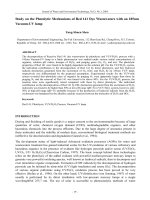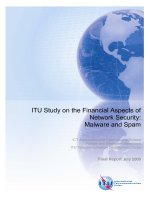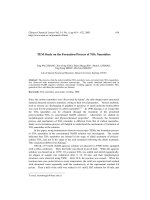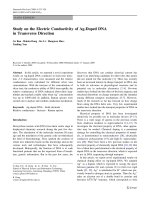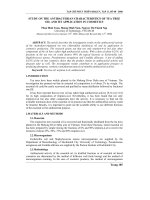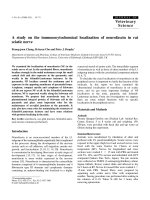Study on the current situation of supply chain for mango production in Cam Lam district - Khanh Hoa province
Bạn đang xem bản rút gọn của tài liệu. Xem và tải ngay bản đầy đủ của tài liệu tại đây (211.15 KB, 6 trang )
Vietnam Academy of Agricultural Sciences (VAAS)
STUDY ON THE CURRENT SITUATION OF SUPPLY CHAIN FOR MANGO
PRODUCTION IN CAM LAM DISTRICT - KHANH HOA PROVINCE
Nguyen Tan Hung1, Ho Huy Cuong1, Do i Ngoc1,
Pham Vu Bao , Tran Quoc Dat1, Nguyen i Hang Ni1, Nguyen Phi Hung2
*1
Abstract
To stabilize and improve the income of local mango producers, a study on current status of mango distribution
was carried out in Khanh Hoa province from 2014 - 2015. Results showed that 3 di erent supply chains have been
available in mango production in the location, including (1) from the producers retailers consumers (7.5 - 7.7%);
(2) from the producers Business owner whole sale markets retailers consumers (92.3 - 92.5%); (3) from the
producers business owner export to China (47.3%). In case of Cam Lam district, mango producers bring their
products directly to the collecting places (producers business owner), they can bene t much better since it has
reduced the intermediate steps. As a matter of fact, the income distribution between producers and collectors was not
transparent; ununiformed and unsafe products are still big problems. Because of that, the establishment of mango
production cooperatives in which farmers have to produce high quality and safe products should be accordingly
recommended.
Keywords: Cam Lam mango, mango status, value chain of mango
INTRODUCTION
Methods
Mango is considered as the main crop of Khanh Hoa
province with 6,042 - 6,467 ha under cultivation in
2012 - 2016 period that produces 40,899 - 41,582
tons/year and earns 400 - 450 billion VND. Cam Lam
is mostly concentrated location of mango production
accounting for approximately 50% of the total area
and production in whole province (from 2012 - 2016,
mango area varied from 2,830 - 3,120 ha with the
uctuated production from 22,952 - 24,828 tons/year)
(Khanh Hoa Statistical Yearbook, 2017). It is
especially mentioned that in recent years, mango
cultivation in Cam Lam district has been gradually
shi ed from small-scale production with many
cultivars to large scale one focusing on the three main
cultivars as Canh Nong, Cat Hoa Loc and Australia
mango (R2E2). ough lots of advantages in mango
production have been achieved,, the unsustainable
income of mango producers in Cam Lam district is
also regarded as a main issue that must be accordingly
solved to nd out appropriate solution for successful
improvement the situation.
Methods used: Data and information concerned
were collected by relevant persons and agencies in
combination with the review conducted from 64
retailers and business owner, and 31 farmers.
OBJECTIVES AND METHODS
ough lots of mango cultivars have been available
in the location studied (Canh Nong, Cat Bo Trang,
Cat Bo Vang, Cat Hoa Loc, Cat Chu, R2E2, Taiwan,
ailand etc.), main demand was concentrated on
three leading cultivars, says, Canh Nong, Cat Hoa
Loc and Australian mango (81.3%, 82.8% and 85.9%,
respectively) (Table 1).
Objectives
e aims of the survey was to assess the strengths and
weaknesses of the current status of mango distribution
in order to nd out solutions for improvement of
mango production in Khanh Hoa province.
1
*
Survey content: Production chains of mango inside
and outside of province; Mango sorting levels in
production and harvesting for the three cultivars;
Method and capacity of mango growers in product
collecting, sorting and preserving; Price uctuations
in the mango crop and between sorting levels; Main
di culties faced to local producers in terms of
production and consumption.
Data and information collected were then analyzed
with the support of Excel program in collaboration
with SWOT method (Humphrey, Albert, 2005).
Time and place of the study
e study was implemented in 2014 - 2015 period in
Cam Lam district Khanh Hoa province.
RESULTS AND DISCUSSION
Current status of mango value chain in Cam Lam
Agricultural Science Institute for Southern Costal Central of Vietnam; 2 University of Da Nang
Corresponding author: Pham Vu Bao. Email:
98
Journal of Vietnam Agricultural Science and Technology - No.1(3)/2018
Table 1. e percentage of wholesalers
and retailers participation in mango collection
and distribution in Cam Lam
TT
Cultivars
e participation
percentage of wholesalers
and retailers (%)
1
Canh Nong
81.3
2
Cat Hoa Loc
82.8
3
Australian
85.9
Although the collection and distribution among the
three cultivars were not much di erent, the targeted
markets, in the other hand, was markedly various
from cultivar to cultivar: For Canh Nong cultivar,
only 7% of production was used in local market and
the rest (approximately 92.7%) was transported to
outsides (Hanoi mainly), for Cat Hoa Loc (Figure 2)
the percentage of local consumption was the same (7.5%)
but outside market was targeted in Ho Chi Minh city.
For the Australian mango (R2E2), though EMU exports
company (Vietnam) has been collecting, preliminary
processing and preserving this cultivar to export to
Singapore, Indonesia, United Arab Emirates, etc.
the quantity was still limited because of its low
competitiveness (Hai Dang and Hong Dang, 2017).
Figure 1.
e distribution chain of Canh Nong mango in Cam Lam
Figure 2.
e distribution chain of Cat Hoa Loc mango in Cam Lam
Figure 3.
e distribution chain of the Australian mango in Cam Lam
99
Vietnam Academy of Agricultural Sciences (VAAS)
From the above mentioned results, the strengths and
weaknesses of mango distribution chains in Cam Lam
could be summarized and recommended as ows:
- e production of 3 mango cultivars Canh Nong,
Cat Hoa Loc and Australian (R2E2) that have been
highly appreciated by traders and consumers should
be prioritized, and
- Traditional consumption markets (northern area
for Canh Nong, southern area for Cat Hoa Loc should
be accordingly strengthened and developed whereas
outside markets rstly China will be targeted for
Australian cultivar.
Consulting the results conducted from the studies
on mango value chains in Tien Giang (Trinh Duc Tri
et al., 2015) and Binh Dinh (Luong Ngoc Trung Lap
et al., 2015), with the conclusion that local collecting
places must go through the small traders before
transferring to collecting places (producers à small
traders à business owner), meanwhile, we propose
that, in case of Cam Lam, the producers had better
to bring their products directly to the collecting
places (producers à business owner) to minimize
intermediate costs.
It is also obvious that, the current status of mango
distribution chains in Cam Lam also reveals the
weakness that the Australian mango (R2E2) was
mainly petty exported to China where the risks are
easily occurred.
Figure 4. Percentage of grading the mango fruits in Cam Lam
Current status of grading, collection, preservation
and price of mango in Cam Lam
Apart from value chain, our studies had also dealt with
sorting, collection, processing and purchase prices of
mango in Cam Lam district. Results showed that: the
the percentage of traders who buy unlimited quantity
of Canh Nong, Cat Hoa Loc and Australian cultivars
(R2E2) were 61.5%, 67.9 5 and 72.7%, respectively
whereas 38.5%, 32.1% and 27.3%, respectively for
limited buyer ones was observed; As calculated,
92.3%, 92.5% and 92.7% of Canh Nong, Cat Hoa Loc
and Australian (R2E2) mango growers, respectively
took their products to collecting places. e sorting/
grading of mango (type 1, type 2 or type 3) in the
transaction was decided by traders depending on
their purposes; 100% traders implemented primary
processing and preservation with simple and hand
made techniques (cutting, using paper towel or cloth
to clean stains or pus on mango fruit, put in plastic
baskets with newspapers, adding calcium carbide
(CaC2) (Table 2).
Table 2. e quantity and method of collecting, grading
and preliminarily processing of mango in collecting places in Cam Lam
Percentage (%)
Cat Hoa Australian
Canh Nong
Loc
(R2E2)
- Unlimited quantity
61.5
67.9
72.7
Collecting capability
- Limited quantity under markets
38.5
32.1
27.3
- Producers bring their mango to collecting places
92.3
92.5
92.7
Collecting methods
- Traders buy mango at farmers’ gardens
7.7
7.5
7.3
- Under the issued criteria
0.0
0.0
0.0
Grading methods
- Proposed by traders
100.0
100.0
100.0
Primary processing - Under the recommended protocols
0.0
0.0
0.0
and preservation
- Raw processing
100.0
100.0
100.0
methods
Criteria
100
Methods
Journal of Vietnam Agricultural Science and Technology - No.1(3)/2018
e above mentioned results prove that the collecting
capability and methods are considered as the strengths
in mango production and value chains in Cam Lam.
Most of sellers demanded unlimited quantity of three
mango cultivars and mango producers transfer their
products to collecting places right a er harvesting
resulting in better bene t gained.
In the other hands, the method of sorting, processing
and preservation were the weaknesses in the mango
value chain in Cam Lam presented by quite low
percentage of local growers applied these practices
with proper technologies that resulted in low quality
fruits, the ratio of grade 1, 2 and 3 were 65.7%, 26.6%
and 7.8% respectively for Canh Nong cultivar, 72.4%,
21.5% and 6.1%, respectively for Cat Hoa Loc and
71.1%, 28.9% and 0%, respectively for Australian
Figure 5.
one (Figure 5). And, what is more, the regulations
in mango sorting of mango ( grade 1: fruit weight
≥ 0.3 kg for Canh Nong, ≥ 0.4 kg for Cat Hoa Loc;
≥ 0.6 kg for Australian cultivars with su ciently
physiological ripe without pest and pus latex ) was
not strictly followed and mainly decided by traders
that impact to product quality.. As a result, in practice
the quantity of fruit of type 1 of the business owner or
rst markets were higher than that of the producers.
is has shown that there was no transparency in the
distribution of mango income between producers
and business owners. Similarly, due to pre-processing
methods, raw processing preservation and manual
labor have also increased the cost of price due to the
rotten rot causing losses and labor increased.
e purchase price of mango type 1 and 2 in Cam Lam
It is also mentioned that, the price of Canh Nong, Cat
Hoa Loc and Australian (R2E2) mango varied from
time to time of harvesting and from grade to grade of
the products. For Canh Nong cultivar, at the beginning
and ending harvest,, the prices of grade 1 and 2 were
VND 11,402/kg and VND 6,011/kg respectively
whereas VND 8,965/kg and VND 4,847/kg were the
prices at mid season (equivalent to 21.4% and 19.4%
decrease). e same situation was also recorded in
cases of Cat Hoa Loc and Australian (R2F2) cultivars.,
For fruit grades, the uctuable prices between grade 1
and grade 2 at the same time of Canh Nong, Cat Hoa
Loc and Australian (R2F2) cultivars were from 45.9
- 47.3%; from 44.2 - 50.8% and from 65.1 - 67.9%.
respectively/ Especially, the prices of Cat Hoa Loc
and Australian (R2E2) were 121.7 - 155.5% and 190.2
- 376.7% respectively compared to that of Canh Nong
at the same time and same grades(Figure 5). It is also
considered as the advantages of these cultivars in
Cam Lam mango production.
Di culties of collectors and producers in mango
value chain in Cat Lam
In short, following di culties should be taken into
account for mango production in Cam Lam district::
* 53.1% for the market;
* 32.8% for transportation;
* 23.4% for capital;
* 56.3% for payment; and
* 0.9% for primary processing and storing.
Of the above mentioned issues, di culties in
nding market related to the price should be paid
great attention to. Producers and collectors mostly
had no information on transportation cost and
price exported to China informally as well. Because
of that, they could not control the selling price, the
transaction with traders and wholesale markets.
Negotiation of selling prices was mainly conducted
by using the phone so there were potential risks, price
competition among collectors in the beginning or the
end of the harvest, selling price competition among
collectors. In addition, the quantity of goods is not
stable, so they did not take the initiative in signing
long-term contracts. In addition, the di culties in
transportation cost and capital etc. presented in Table
3 are also considered as big problems that need to be
appropriate solved.
101
Vietnam Academy of Agricultural Sciences (VAAS)
Table 3. Di culties in the mango consumption chain in Cat Lam
Percentage of
collectors meeting
di culties (%)
Evaluation
Criteria
- Di culties in the
market
53.1
- Di culties in
transportation
32.8
- Di culties in capital
23.4
- Di culties in
payments
56.3
- Di culties in
preliminary processing
and storing
10.9
Di culties in collection and distribution activates
- e price and the demand are not stable.
- Lack of information on wholesale price
- Have to have prices of buying and selling to be completed with
the others collectors.
- e volume of goods is not stable.
- High transportation costs.
- Not being active in transportation.
- Insu cient capital for business .
- Di cult to approach the capital support policies.
- Traders do not pay.
- Traders hoard goods to take advantage of capital.
- e landlords do not repay the pre-received loan when the high
price or loss of crops
- Short storage time and highly rotting rate of post-storage.
Strengths and weaknesses in mango consumption chain in Cam Lam
Strengths
Weaknesses
- Areas of commercial mango production have been - e consumption market of Australian mango (R2E2)
is not sustainable.
established with 3 main cultivars: Canh Nong, Hoa
Loc, Uc (R2E2) and classi cation of mango Type 1 in - e prices of collection and consumption are unstable.
production makes up the high rate.
- e source of goods is not stable.
- e market has the demand and has established
- e price of mango Canh Nong is too low.
the traditional consumption market of mango, Canh - ere is no transparency in the distribution of mango
Nong, Cat Hoa Loc and Uc (R2E2).
income between producers and collectors.
- Limited the intermediary of traders in the chain of - Low competitiveness due to higher post-harvest
movement from producers to consumers.
costs (short storage time, high postharvest losses, high
- Although not yet being close and sustainable, the
transporting costs, lack of market information).
link between producers and owners has been formed. - ere is no strong and sustainable link between
producers and collectors between collectors.
Solutions to improve the e ciency of mango
production in Cam Lam
With the assessments resulted fro study on the
current status of mango production in Cam Lam
district, following considerations should be taken
into account for improvement the situation:
- To train local growers technologies needed for
improving the yield and quality of mango cultivars
traditional developed.
cultivation techniques applied.
+ Establishment of the linkage linkages among
producers, collectors and traders to accordingly form
the e ective chains for sustainable production of
mango in whole district.
+ Providing information related to mango commercial
situation inside and outsides of the province and
policies concerned as well.
- To establish mango production Cooperative/s to be
in charge of following tasks:
+ Contribution in combining mango production
related companies in the province and nding new
markets including export ones
+ Recommendations on mango varieties including
newly introduced ones to be properly cultivated in
di erent locations in Cam Lam district with suitable
+ Consultation on speci c equipment used for mango
preservation and transportation to keep product
quality stable with high price.
102
Journal of Vietnam Agricultural Science and Technology - No.1(3)/2018
- e price of mango is much di erent from time to
time of the harvest (21.4 - 31.8% di erence) and from
grade to grade of the product
Grant, R.M., 2010. Contemporary Strategy Analysis, 7th ed.
John Wiley & Sons, p. 239-241.
Hai Lang, Hong Dang, 2017. Swarm into variety
Autralia mango (H2R2) in Cam Lam - Khanh Hoa.
Available from: , accessed
on 15/7/2018 (in Vietnamese).
Humphrey, Albert, 2005. “SWOT Analysis for
Management Consulting”, RI Alumni Newsletter.
SRI International, United States. Available from:
/>accessed on 15/7/2018.
Luong Ngoc Trung Lap, Nguyen Minh Chau, 2015.
Analysis of the value chain of mango in SouthCentral Coastal Vietnam. Sustainable and pro table
crop and livestock systems in South-Central Coastal
Vietnam. ACIAR, page 161-170.
NetMBA, 2010. Value Chain. Available from: http://
www.netmba.com/strategy/value, accessed on
15/7/2018.
Trinh Duc Tri, 2015. Study on value chain for mango in
Tien Giang. Can o University Journal of Science, 40
(2015), page 92-104 (in Vietnamese).
REFERENCES
Khanh Hoa Statistics O ce, 2017. Khanh Hoa
Statistical Yearbook 2017. Statistic Publishing House
(in Vietnamese).
Date received: 12/10/2018
Date reviewed: 17/10/2018
Reviewer: Assoc. Prof. Dr. Vu Manh Hai
Date approved for publication: 21/12/2018
- Negotiation with local governors in improving the
infrastructural condition and policies concerning to
improvement mango production in Cam Lam district
CONCLUSIONS
- Mango is one of major agricultural products in
Khanh Hoa with 40,899 - 41,582 tons per year in
which Canh Nong, Cat Hoa Loc targeted for local
consumption and, R2E2 for export to China were
regarded as three leading cultivars .
- In 3 mango value chains available, including (1)
from the producers retailers buyers (7.5 - 7.7%);
(2) from the producers
Business owner
clue
markets retailers buyers (92.3 - 92.5%); (3) from
the producers business owner
export by petty
trades to China (47.3%), the third one (producers
business owner) should be recommended because of
intermediate cost reduction.
LIGHT TRAPS: AN EFFECTIVE METHOD FOR CONTROLLING
THE SUGARCANE GIANT BORER Phragmataecia castaneae IN VIETNAM
Cao Anh Duong*1, Duong Cong
ong1, Do Duc Hanh1, Do Van Tuong 1
Abstract
e sugarcane giant borer Phragmataecia castaneae is one of three important sugarcane borers in Vietnam, beside
the internode borer Chilo sacchariphagus and the big pink borer Sesamia sp. Some studies on light attractive levels of
some sugarcane borers species, monitoring and controlling the sugarcane giant borers by light traps were carried out
in Vietnam from 2010-2014. e results proved and indicated that light trap was an e ective method for controlling
the sugarcane giant borer in Vietnam. is method is a safe pest control for environment and human, so it could be
recommended for applying to other similar sugarcane planting regions.
Keywords: Sugarcane giant borer Phragmataecia castaneae, sugarcane borer, sugarcane, light traps, light
attractive, monitoring
INTRODUCTION
Sugarcane is an important agro-industrial crop
in Vietnam, occupying 268,300 hectare area. It is
grown in di erent agro-climatic regions, spreading
from the North to the South. e average cane yield
in Vietnam is about 64.8 tons per hectare while the
sugar recovery (CCS) is around 9.62 percent (MARD,
1
*
2017). However, there is potential of increasing the
average cane yield to 100 tons per hectare and sugar
recovery to 11.0 percent, if new technologies are
transferred to the farmers, especially on varieties and
pests management.
ere are the most important
factors limiting sugarcane production in Vietnam
(MARD, 2017).
Sugarcane Research Institute (SRI)
Corresponding author: Cao Anh Duong. Email:
103
